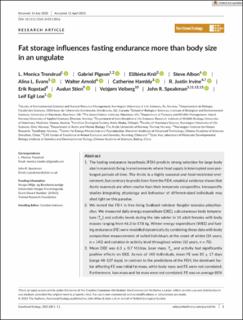| dc.description.abstract | The fasting endurance hypothesis (FEH) predicts strong selection for large body size in mammals living in environments where food supply is interrupted over prolonged periods of time. The Arctic is a highly seasonal and food restricted environment, but contrary to predictions from the FEH, empirical evidence shows that Arctic mammals are often smaller than their temperate conspecifics. Intraspecific studies integrating physiology and behaviour of different‐sized individuals, may shed light on this paradox. We tested the FEH in free‐living Svalbard reindeer (Rangifer tarandus platyrhynchus). We measured daily energy expenditure (DEE), subcutaneous body temperature (Tsc) and activity levels during the late winter in 14 adult females with body masses ranging from 46.3 to 57.8 kg. Winter energy expenditure (WEE) and fasting endurance (FE) were modelled dynamically by combining these data with body composition measurements of culled individuals at the onset of winter (14 years, n = 140) and variation in activity level throughout winter (10 years, n = 70). Mean DEE was 6.3±0.7 MJ day−1. Lean mass, Tsc and activity had significantly positive effects on DEE. Across all 140 individuals, mean FE was 85±17 days (range 48–137 days). In contrast to the predictions of the FEH, the dominant factor affecting FE was initial fat mass, while body mass and FE were not correlated. Furthermore, lean mass and fat mass were not correlated. FE was on average 80% (45 days) longer in fat than lean individuals of the same size. Reducing activity levels by ~16% or Tsc by ~5% increased FE by 7%, and 4%, respectively. Our results fail to support the FEH. Rather, we demonstrate that (i) the size of fat reserves can be independent of lean mass and body size within a species, (ii) ecological and environmental variation influence FE via their effects on body composition, and (iii) physiological and behavioural adjustments can improve FE within individuals. Altogether, our results suggest that there is a selection in Svalbard reindeer to accumulate body fat, rather than to grow structurally large. he Arctic, activity, biologging, daily energy expenditure, doubly labelled water, intraspecific scaling, subcutaneous body temperature, Svalbard reindeer | |

